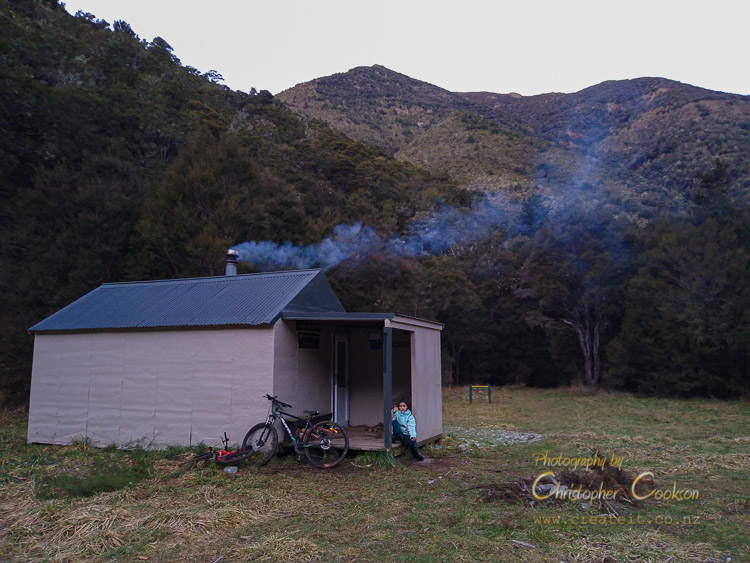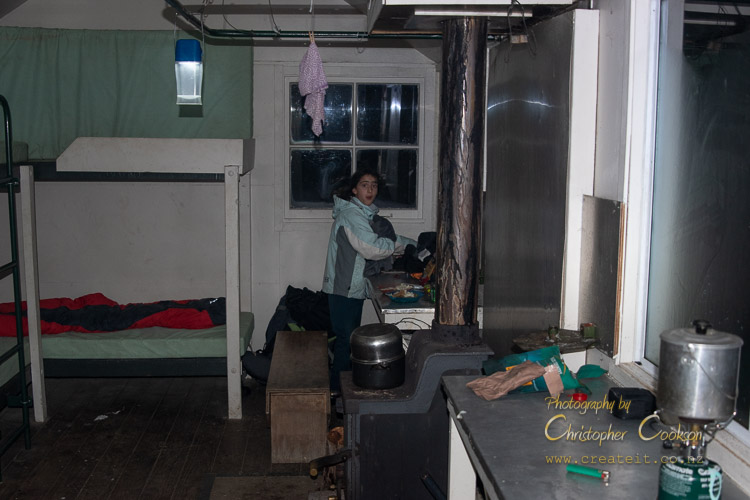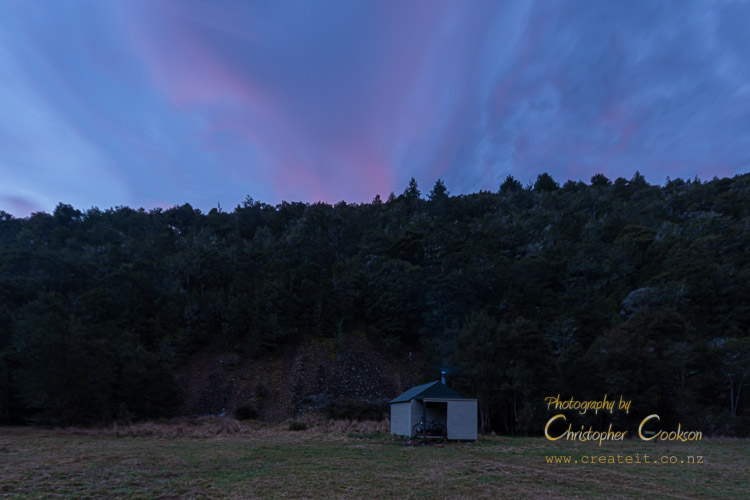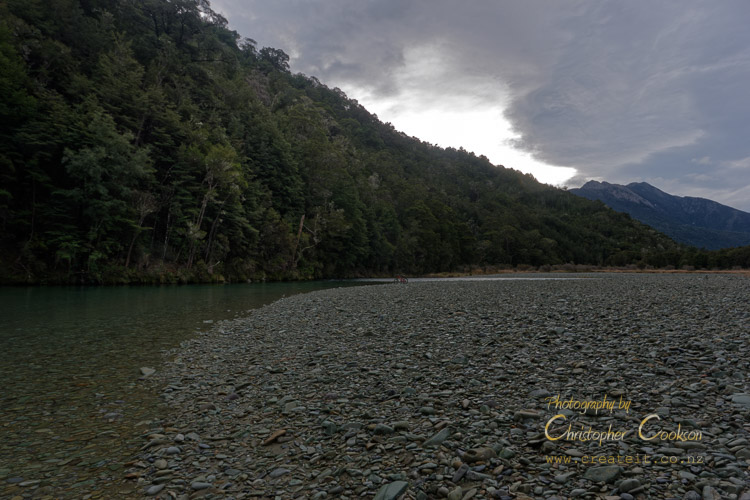A Marlborough School Holidays Winter Wilderness Adventure
By: Christopher Cookson
Last Modified: 4-8-2021 23:14

A frosty evening
© Christopher Cookson License this image
It was a bright and sunny Wednesday afternoon when my daughter and I packed our bikes, hers in the boot, and mine on the bike carrier back of our somewhat shabby, silvery grey Honda Civic, and set off for an adventure she’d been begging for, for months. Marlborough has over 60 DOC huts ranging from basic two bunk bivvys with no heating up to multi-room huts with wood stoves, water on tap, and accommodation for more than a dozen people. My daughter had never experienced a night in a hut before, and was determined that she wanted to do so before the end of the school holidays.
I had to work the first part of the week, but one of the joys of self-employment is that you can take time off whenever it suits as long as you are sufficiently up to date with work.
Looking at the weather forecast, I decided that Wednesday was probably the last opportunity we’d have for a tramp before the weather turned wet for the remainder of the week. In hindsight, that was probably the underestimate of the century, as after our safe return, rain continued falling until it caused Marlborough’s biggest flood event ever recorded. On Wednesday afternoon though, all of that was yet to come, and a brilliant blue sky after a frosty start made for a perfect day for a tramp, and my biggest concern was cold rather than rain.
Some careful examination of Marlborough’s network of huts made me decide that the Lower Goulter Hut would be the most appropriate option for a mid winter expedition. I didn’t want to get wet feet crossing any icy streams at this time of the year, and leaving in the afternoon, I knew we weren’t going to have a lot of hours of daylight. It’s a bit over an hour’s drive from Blenheim to the end of two wheel drive access along the Goulter Road, then about another twelve kilometres of four wheel drive track, and finally a couple of kilometres of tramping track to the hut. My wife was very sceptical of a mid winter adventure, and declined to participate, however resigned herself to our daughter’s enthusiasm, and reluctantly let us go.
As we headed out west, we made a quick stop at the supermarket to grab some supplies. My father was always a keen tramper in his younger years, and taught me to always be prepared for at least a day longer than you intend to stay when you head into the back country, so that if things go wrong, you can stay put. My daughter is a little carnivore with a severe nut allergy, so rather than the traditional scroggin I remember from when I was a kid with a mixture of nuts, dried fruit and chocolate, I bought some beef jerky for the trail, if I could keep her out of it till we got there.
As we headed out north from Renwick and over the Wairau River at Kaituna, I thought the river looked unseasonally low for the middle of winter. Little did I know that three days later it would be off the charts with the volume of water raging down it.
Turning off onto the north bank road, I checked the DOC sign with the status of access points to Mount Richmond Forest Park, and everything was good, so we drove on, my daughter chattering away in anticipation, looking out for horses along the way.
Once we got into the shadow of the hills the signs that it was the middle of winter became obvious with patches of frost, and frozen puddles of ice along the roadside. I drove slowly in the shady sections of road as a precaution, as I didn’t trust the road conditions. It turned out my anxiety was well founded, as some way up the valley, where the road is lined with willows in a swampy area on one side, and a steep, shady hillside on the other, we spotted lights flashing from an overturned ute, down a bank with its wheels in the air. I quickly reversed, stopped the car, and put the hazard lights on and went to take a look, and a very shaken family came crawling out from the overturned vehicle and up the bank. Thankfully, apart from a few blackberry scratches, they seemed to be OK, but we stuck around and I offered them a ride even though our car was quite full with tramping gear and my daughter’s bike, as they weren’t dressed for a long walk in chilly conditions. As I was working out how to reorganise the car, another ute came along, and stopped to see what was going on. It turned out to be a neighbour of the family, so my ‘taxi service’ was no longer required, and our tramp was back on.
The rest of the drive was uneventful, and we were even pleasantly surprised to find that we were able to make it about a kilometre past the official end of the two wheel drive road, before I decided that a dry ford was full of too many large boulders to negotiate in our car.
I parked the car a few metres back from the ford off the road and it was time to unload our bikes and packs, and make our way under our own strength. A farmer and female companion came past in his ute, weather beaten, and with the remains of a roll-your-own in his mouth, and on asking us our plans, offered to take us and our bikes to the end of the four wheel drive track. As it turned out, this was quite fortuitous, as we’d arrived quite a bit later than I’d originally planned, and though making the hut was certainly possible, it was far more comfortable not having to ride the fourteen kilometres or so to the hut. It was almost like there was some kind of natural reciprocity going on, as we’d stopped earlier on to make sure someone else was safe, and now we were offered some assistance that made our adventure a great deal easier and possibly made the difference between an enjoyable experience and something I’d spend years trying to live down.
I was quite surprised to find as we rode along in the back of the ute that I was getting a good mobile signal in the middle of nowhere, and commented on it. The farmer mentioned that a new mobile tower had been installed across the Wairau on a hill only recently. He pointed it out between the roadside mānuka scrub, as we drove. Apart from a couple of small stream crossings, the four wheel drive track would have been mostly negotiable in an ordinary car, and I was confident we’d have a straightforward ride back the next day.
Across a larger stream crossing, a green and gold sign announced that we were entering Mount Richmond Forest Park, and the trees began to become taller and the forest denser, with the black trunks of beech trees standing out amongst the smaller vegetation.
We soon arrived at the end of the vehicle track, where a couple in a campervan were enjoying drinks around a campfire. We unloaded our bikes and packs, and thanked the farmer, who went over to greet the couple around the fire.
My daughter and I were on our own now with our bikes and packs, and the sound of the rushing river below us. Here the Goulter rushed along with patches of white water between deep, clear, pools far below us, and the track ahead was steep and strewn with scree from the schist rocks of the area, climbing for the first bit so that we had to push our bikes. Although parts of the track were rough, the track was broad enough and in good enough shape that a narrow vehicle could probably have made it along most of it. In spite of various uphill sections, we found numerous sections that were easy to ride, and wide enough to ride side by side.
Soon we could see a bend in the river where it disappeared behind a bushy spur, and according to my reckoning from the map and GPS on my phone, that should be where the hut should be. Sure enough, we rode out into a flat, grassy clearing surrounded by kānuka and mānuka forest with a steep hillside to the east and the river to the west, with the drab, khaki hut set back from the river nestling close to the hillside. Away amongst the trees on the edge of the clearing was the ‘long drop’, to cater for bodily functions.
Golden light from the sun at the end of the day was illuminating the tops of the mountains above us to the east, but the clearing and the hut itself were already in shade. Because we’d been riding our bikes, and had warm, windproof layers on, we didn’t feel cold, but surveying the clearing we could see that things were cold. After we unloaded our packs, I set to work gathering firewood, to avoid depleting the hut’s existing stocks, by taking one of the saws hanging up in the entrance, while my daughter took to rolling around in the frost that had persisted all day, and formed a white coating on the ground in the clearing and on some bare ground on the hillside behind the hit.
Inside the hut, I found a full bottle of dishwashing detergent that someone had left that was frozen solid. Most substances other than pure water tend to have a freezing point well below zero, which is the principle of of antifreeze in vehicle radiators, so I worked out that if the dishwashing detergent had frozen solid inside the hut and stayed that way all day, temperatures must have been well below zero for a long time.
Like many DOC huts, there was an iron log burner to provide heating, and once I had enough firewood and kindling, it was time to make a fire to keep us warm. The grate was full of ash from the last users, so I had to dispose of this before I could get started.
The kānuka forest around the clearing provided an ample source of kindling although the strips of loose bark were a bit damp, and I needed to use a small amount of our toilet paper supply, and some careful blowing to bring the fire to life. Once I’d got the fire going though, I’d gathered a good supply of kānuka logs from fallen trunks in the forest that would be enough to keep the fire burning through the night.
The air was still, and the smoke from the fire rose up lazily from the chimney and wafted around the clearing.
After sufficient time rolling in the frost, my daughter was ready to help, and I sent her with a pot to fetch water from the river, which was about a metre down a bank at the edge of the clearing. Kids seem to have an affinity for water even in the coldest of conditions, so I gave her a stern warning not to fall in or go paddling over her boots. She cheerfully went off and collected water and we put a pot on the fire, although I decided that if we were going to have dinner by a reasonable time, I’d need to use our gas cooker. I set up our cooker on one of two stainless benches in the hut, and opened the window behind it a little to avoid humidity and carbon monoxide accumulation. I put some of the water from the pot into a billy, and put it on to boil.
While the water was heating, I picked up the hut book beside me and made an entry for us and read the details of previous visitors. To my surprise, family wilderness expeditions in the middle of winter weren’t exclusively for crazy people like us, and just four days ago, an entire family had driven all the way from Kaikōura to spend a night together in the hut. At least I could now provide supporting evidence to my wife when we got home that I was not completely mad, or at least if I was, I was in good company.
For dinner, we divided a pouch of freeze dried roast lamb and vegetables. Preparation was basically a case of just add water and wait, so couldn’t have been easier. While we were waiting, we sorted out our bedding arrangements. One of the reasons I’d picked the Lower Goulter Hut was that it was an eight bunk hut, so if by chance anyone else had been there, we’d still have a chance of getting a bunk. As it turned out, we had the place to ourselves, so could spread out as we pleased. My daughter suggested we sleep in a corner, with her along one wall, and me along another so that she could grab my hand for comfort if she wanted to during the night. By now things were getting quite dark, but we had a solar chargeable lantern that I hung up so that we could see as we lay down the eggshell blue mattresses and took our sleeping bags out. In addition to sleeping bags themselves, we each had bright orange silk sleeping bag liners for an extra layer of insulation, and this along with the fire meant that I felt confident that no matter how cold it got outside, we’d have a cozy night.

© Christopher Cookson License this image
We divided our pouch of dinner into two plastic plates, and sat down on a wooden bench at one of the stainless steel benches to each. We ate well, indeed I found I ended up having to be a scavenger and clean up some of my daughter’s left-overs as although she was enthusiastic about the taste of the food, she complained it was too much for her. Something about chocolate biscuits and beef jerky on the ride in might have had something to do with this, but we didn’t have anyone around to scold us for poor nutritional choices, and it was only for one night anyway.
While our nutritional choices might not have been the healthiest, I certainly couldn’t be criticised for not ensuring my daughter got adequate sleep. After dinner, we cleaned our plates and went outside briefly to have a quick look at the starry sky, with the Milky Way glittering overhead, but then there was nothing else to do but go to bed. We were in bed by seven, and as my daughter drifted off to sleep in her sleeping bag, securing my hand, she murmured that it was the best adventure ever, and wished that she could live in a hut. I thought to myself that with eight bunks, it just possibly could be a setting for Snow White and the seven dwarfs, as it had just the right amount of accommodation, although sometimes real life adventures are better than fairy tales.
I awoke around one in the morning with a cough, which also woke up my daughter, so I took the opportunity to check the fire, which turned out to still have a good bed of embers. I put another log on, and we went back to sleep, waking up just after seven with the grey light of dawn. My daughter had a recently acquired watch, so promptly informed me of the time when she woke.

© Christopher Cookson License this image
We boiled up some water again in the billy with our gas cooker, and had ‘just add water’ porridge for breakfast, along with a good cup of coffee for me and chai latte for my daughter. Outside, the sky had clouded over, although there was still some blue about, and a pinkish-purple tie dyed kind of sunrise greeted us.
Once we’d eaten, cleaned up after ourselves, and packed our gear, we decided to explore a bit. It was still early, and rain wasn’t predicted till evening, so we had plenty of time before we needed to be back at the car. According to a sign by the hut, the track led on to another hut three to four hours further on up the river, depending on whose reckoning you relied on, or another one up a ridge to a mountaintop hut six hours on. The fork in the track that led to these two different huts was only a few minutes on from where we were, so I gathered camera equipment, and my daughter jumped on her bike, and we set off a few minutes up river to see what we could find.

view north east with Mount Edelweiss in the distance.
© Christopher Cookson License this image
Where the tracks forked, the river opened out a little and we came out behind a spur where we had an unobstructed view up the valley to the high, bare peak of Mount Edelweiss to the north east. To the west, forested slopes rose up from the river. A broad, flat, shingle riverbed stretched out upstream of where the track met the river, covered in mostly small stones with the occasional piece of quartz, but a surprisingly large amount of some greenish stone with smaller greenish pieces embedded, almost like a green concrete, that my limited geological knowledge could not identify.
Although the day was overcast, the clear, deep water was a turquoise colour, in still pools that would make a great swimming hole in summer, but at present had patches of ice around the banks in the shallows. My daughter collected some bits of ice, and apparently immune to the cold, played with them in the water near the bank.
After some time enjoying the tranquillity of the place, it was time to return to the hut and get our packs and set off on the return journey.

© Christopher Cookson License this image
The return trip was easier than the day before as although there were some steep uphill sections, more of the route was downhill on the return which gave us more opportunity to ride our bikes. The weather began to turn, and by the time we were back at the four wheel drive road end, it was drizzling, although we had good weatherproof gear so it didn’t bother us.
With the four wheel drive track in front of us the rest of the way back to the car, cycling was much easier now, although there were some uphill sections that my daughter grumbled about, as her shorter legs made it hard for her to keep up. By the time we were back with mobile coverage, it was raining, although not hard, and we had to look for shelter so that we could stop for lunch. With mostly kānuka forest, there wasn’t much about, but eventually we found a large beech tree growing by a bank that offered some degree of shelter where we were able to take a refreshment break, from then on, it was simply a case of persisting till we got to the car. We reached it as the rain became steadier, although still not heavy. It turned out subsequently that the rain that had begun as light drizzle on our way home, didn’t let up for the next three days, and ended up causing one of the biggest floods in recorded history, however by then, we were long gone, safely back home, mission accomplished, with my daughter having experienced her first night in a DOC hut.
Web Links
Cite this page
Cookson, C. (2021). A Marlborough School Holidays Winter Wilderness Adventure. Retrieved April, 19, 2024, from https://www.marlboroughonline.co.nz/marlborough/information/commentary/a-marlborough-school-holidays-winter-wilderness-adventure/
Be part of the conversation
Sign up to post comments.